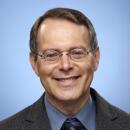Characters Collide in ‘Copenhagen’
- Share via
“Mathematics becomes very odd when you apply it to people,” says one of the physicist characters in “Copenhagen.” “One plus one can add up to so many different sums....”
This tantalizing incalculability suffuses Michael Frayn’s play, which has thrilled audiences in London, New York and Los Angeles. While the main national tour concluded its L.A. run over the weekend, another production, based on the same staging, opened at the Laguna Playhouse before traveling to some smaller cities that the other tour won’t reach.
The Laguna Beach staging is essentially the same as the previous ones, which leaves its new actors as the variables. As of Saturday’s opening, they weren’t quite computing. Still, they showed promise; with a few more performances behind them, they should be able to propel this production toward the same heights as the others.
Part of the thrill of Frayn’s play is reaching its end and feeling you’ve understood it. The dialogue is filled to bursting with names, dates and places, along with principles of quantum physics and nuclear fission.
The characters, meanwhile, behave in the same tricky, hard-to-quantify manner as the atomic particles they’re discussing.
The mystery at the play’s core is a real one. In 1941, when both the Germans and the Allies were trying to assess the viability of nuclear weaponry, two pioneers of atomic physics--the German Werner Heisenberg and the Dane Niels Bohr--met secretly while Heisenberg was visiting Copenhagen. Heisenberg, the developer of the uncertainty principle, had been a student of Bohr, whose understanding of the atom had led to breakthroughs in quantum theory.
Was Heisenberg trying to get his former mentor to reveal knowledge of the Allies’ nuclear plans? Or was he trying to warn Bohr of Germany’s designs? And, had Heisenberg been able to ascertain the Allies’ progress, would he have worked more diligently to provide Germany with an atomic weapon? Or was he trying to establish an understanding by which physicists on both sides would stall progress toward instruments of mass destruction?
Frayn sets the action in the afterlife, as Heisenberg (Sean Arbuckle) tries once again to make his intentions clear to Bohr (William Cain) and his sharp-witted wife, Margrethe (Tanny McDonald). They meet in a heavenly lecture hall, re-created with the same curving, blond-wood walls and global floor inlay as seen in Los Angeles, but without the seating gallery that turned some theatergoers into onstage observers.
Michael Blakemore’s original staging, which puts the actors in electron-like orbits, also has been re-created.
Cain gives Bohr a gruffness born of intellectual rigor. His line delivery is not as musical as that of singer-actor Len Cariou in Los Angeles, but it has its own raspy sonority.
Arbuckle nicely balances Heisenberg’s heady impetuosity with cautious calculation. The approach is more reserved than the daredevil, college-boy tack taken by Hank Stratton, but just as valid. And while McDonald hasn’t yet found the complexity in Margrethe that Mariette Hartley displayed, she lends gravity to the proceedings.
The characters’ final, particle-like collision results not in an explosion, but a hug. Frayn seems to suggest that if people can but reach a moment of understanding, catastrophe might be averted. As the nuclear powers of India and Pakistan stare each other down, that message resonates with renewed urgency.
*
“Copenhagen,” Moulton Theater, 606 Laguna Canyon Road, Laguna Beach. Tuesdays-Fridays, 8 p.m.; Saturdays, 2 and 8 p.m.; Sundays, 2 and 7 p.m. Ends Feb. 3. $42 and $49. (949) 497-2787. Running time: 2 hours, 40 minutes. This tour plays at San Diego’s Spreckels Theatre from April 23-28.
More to Read
The biggest entertainment stories
Get our big stories about Hollywood, film, television, music, arts, culture and more right in your inbox as soon as they publish.
You may occasionally receive promotional content from the Los Angeles Times.











